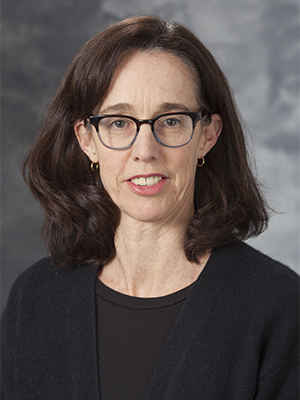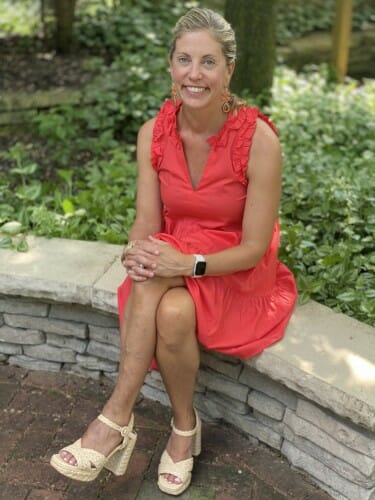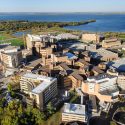Clinical trial repurposes cancer drug for treatment of vascular malformations
Beth Drolet, chair of the Department of Dermatology at the University of Wisconsin School of Medicine and Public Health, is motivated by the stories of the pain and disfigurement that some of her patients experience.
She treats patients with vascular anomalies, which are the result of abnormal blood and lymphatic vessel development, and sometimes come with accompanying overgrowth of the bones and soft tissues. Over time, patients with these anomalies can suffer from pain and loss of function due to multiple factors, including blood clots, bleeding, and progressive growth of blood vessels.

Beth Drolet
Despite advances in gene discovery, treatment remains mainly procedural via surgery and other invasive procedures. Relief from these treatments is most often temporary.
Drolet is trying to change that by driving forward an early phase clinical study to offer more lasting help to her patients and others like them. The multi-site trial at UW–Madison is in its first phase and is testing a personalized topical medication in the form of a gel as a way to treat vascular anomalies.
“This trial is really the epitome of precision medicine,” Drolet says. “We evaluate each patient before they enter the trial to determine which gene is mutated within their malformation. Once we have that data, we use a drug developed to target the specific pathway that the mutated gene has altered.”
The topical gel, called VT30 Topical Gel, allows Drolet and other trial researchers to deliver the drug directly to the affected tissue through the patient’s skin, which also limits exposure of the medication to healthy tissue.
“Delivering the right drug to the right patient and administering it precisely to the tissues that need the medication will increase efficacy while reducing the risk of unanticipated side effects-precision medicine,” Drolet says.
The phase 1/2 study has enrolled patients who have venous, lymphatic, and venolymphatic malformations, which are tumor-like lesions combined both venous and lymphatic vessel structures. The study is evaluating the safety of the drug and how well patients tolerate its use.
The majority of these vascular malformations are driven by mutations in genes that govern the formation of vessels, called PIK3CA and TEK, resulting in overactivation of pathways involved in their development.
Drolet says the idea to create a medication to treat vascular abnormalities actually came to her in a dream. And now, it’s taken off.
“We had a 16 -institution network to discover which genes cause vascular anomalies and once we and others found the genes, industry became interested in repurposing cancer medications for treatment of this rare disease,” Drolet explains. “This is the first trial in the world delivering targeted gene therapy in a cream for vascular anomalies. It is transformational.”
Early on, Drolet worked with a drug company, BridgeBio Pharma, Inc. and its affiliate Venthera, to engage patient organizations and national experts for their help gathering input on clinical trial design and drug delivery design. The company is focused on developing new treatment options for patients with rare vascular anomalies.
“It’s a big deal,” says Drolet, who has served as a consultant for Venthera and on its medical advisory board.

Sara King, a schoolteacher in Wauwatosa, is taking part in a clinical study focused on patients with mutations associated with Klippel-Trenaunay syndrome and of another syndrome marked by vascular abnormalities. Submitted photo
Sara King, a school teacher in Wauwatosa, Wisconsin, agrees.
She met Drolet when Drolet was at the Children’s Hospital of Wisconsin, serving as the Medical Director of Birthmarks and Vascular Anomalies (where she also established the Birthmarks and Vascular Anomalies Center).
When the doctor joined UW–Madison in 2019, King followed her for treatments.
King has Klippel-Trenaunay syndrome, which carries three characteristic features: a red birthmark called a port-wine stain, abnormal soft tissue and bone growth, and vein malformations. It is a rare, genetic disorder apparent at birth that affects about 70,000 people in the United States.
But King wasn’t diagnosed right away. In fact, she recalls: “When I was born, the doctors told my parents that my birthmark would be gone by the time I turned 3 or 4-years old.”
Few knew at the time that her birthmark, which extends from her hip to her big toe on her left foot, was the hallmark of a rare disease. Forty-four-years later, the birthmark has not gone away.
King didn’t even get her Klippel-Trenaunay syndrome diagnosis until she experienced a blood clot during her third pregnancy.
In addition to making her more prone to clots, the syndrome causes varicose veins and another condition called arteriovenous malformation, both of which King says are very painful. She wears a compression wrap on her leg to help with the pain and has tried many treatments, including vein stripping, to remove varicose veins; sclerotherapy, used to shrink blood vessels; and stent placement, to help with blood flow.
Last December, she learned about the clinical trial and, after an evaluation, was invited to participate. The study is broadly focused on patients with mutations associated with Klippel-Trenaunay syndrome and of another syndrome marked by vascular abnormalities, called PHACE, which affects fewer than 5,000 people in the United States.
King’s treatment in the trial has targeted a 10-by-10 centimeter area of her birthmark. She applies the gel once a day. As part of phase 1, King started with a low dose of the medication, and after two weeks, she returned to the clinic. There, researchers used a special camera to photograph and measure any changes in redness and volume in the treated area of her birthmark. She was sent home to start on an increased dose for another two weeks.
King has recently completed the first phase and is interested in continuing onto phase 2 of the trial, which involves a 12-week randomized, double-blind and placebo-controlled treatment focused on the safety and efficacy of the topical medication.
Though it’s a nationwide study, UW–Madison and UW Health have been efficient in enrolling the trial’s first patient and currently have the most patients enrolled. This is due in part to another study Drolet runs at UW that receives vascular specimens from 16 sites around the world. With about 300 patients enrolled in that study, she can look at that list and pinpoint patients who might have the mutations the gel is targeting.
“The patients are amazing,” says Drolet. “They want to help science and help people to feel better.”
King’s motivation to join this, her first clinical trial, is multi-fold.
“Of course, there is the potential for personal benefit,” King says. “But also, this is cutting-edge and I’m excited to be one of the first people in the world to try this treatment. These doctors are top in their field and it is exciting to have them caring for me.”
King adds that having a rare condition can be isolating.
“It helps me to know that there are other people who I connect with through a study like this, people from around the country,” she says. “I’m also a teacher and it’s fulfilling to know that as a middle-aged woman, I could possibly do something that could impact children and their families. Some of the things that I have faced because of my condition have been scary and painful and if I can alleviate that for someone else, that feels really good.”
For Drolet, the experience has similarly been profound.
“I didn’t imagine how emotional it would be to see the first patient apply the drug,” Drolet says. “I have been talking to some of my patients about the potential for this type of treatment for over five years … It’s a dream come true.”
For more information about the trial, which is still recruiting patients, visit: clinicaltrials.gov/ct2/show/NCT04409145.



